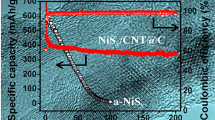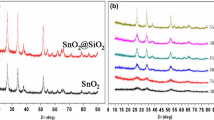Abstract—
We have studied the performance of nanotubular nickel hydrosilicate and its derivatives as a negative electrode of lithium ion batteries. Nickel hydrosilicate with the composition Ni3Si2O5(OH)4 was synthesized under hydrothermal conditions (350°C, 14 MPa, 10 h). Its derivatives were prepared by thermal annealing at temperatures of 400, 600, and 1000°C. In this process, the tubular structure of the particles persisted up to 600°C, whereas at 1000°C well-crystallized Ni2SiO4 was formed. Charge/discharge cycles were performed in the voltage range 0.05–3 V at a specific current of 10 mA/g. Heat treatment was shown to increase discharge capacity and reversible capacity in the first cycle. The highest performance was offered by the material heat-treated at 400°C: its discharge capacity reached 678 mAh/g and its reversible capacity was 58% in the first cycle and 85% in subsequent cycles.







Similar content being viewed by others
REFERENCES
Yoshino, A., Sanechika, K., and Nakajima, Jpn. Patent 1989293/5, 1985.
Nagura, T. and Tazawa, K., Prog. Batteries Sol. Cells, 1990, vol. 9, pp. 20–29.
Tarascon, J.-M. and Armand, M., Issues and challenges facing rechargeable lithium batteries, Mater. Sustainable Energy, 2011, vol. 414, pp. 171–179. https://doi.org/10.1142/9789814317665_0024
Perla, B.B. and Yixuan, W., Lithium-Ion Batteries: Solid-Electrolyte Interphase, London: Imperial College Press, 2004, p. 407.
Kazunori, O., Lithium-ion rechargeable batteries with LiCoO2 and carbon electrodes: the LiCoO2/C system, Solid State Ionics, 1994, vol. 69, nos. 3–4, pp. 212–221.https://doi.org/10.1016/0167-2738(94)90411-1
Xue, L., Savilov, S.V., Lunin, V.V., and Xia, H., Self-standing porous LiCoO2 nanosheet arrays as 3D cathodes for flexible Li-ion batteries, Adv. Funct. Mater., 2018, vol. 28, no. 7, paper 1705836.https://doi.org/10.1002/adfm.201705836
Da Silva, S.P., Sita, L.E., dos Santos, C.S., Pavoni, F.H., de Santana, H., Andrello, A.C., and Scarminio, J., Physical and chemical characterization of LiCoO2 cathode material extracted from commercial cell phone batteries with low and high states of health, Mater. Chem. Phys., 2018, vol. 213, pp. 198–207.https://doi.org/10.1016/j.matchemphys.2018.04.038
Yang, Q., Huang, J., Li, Y., Wang, Y., Qiu, J., Zhang, J., and Chen, L., Surface-protected LiCoO2 with ultrathin solid oxide electrolyte film for high-voltage lithium ion batteries and lithium polymer batteries, J. Power Sources, 2018, vol. 388, pp. 65–70.https://doi.org/10.1016/j.jpowsour.2018.03.076
Padhi, A.K., Nanjundaswam, K., and Goodenough, J.B., Phospho-olivines as positive-electrode materials for rechargeable lithium batteries, J. Electrochem. Soc., 1997, vol. 144, no. 4, pp. 1184–1194.https://doi.org/10.1149/1.1837571
An, C., Zhang, B., Tang, L., Xiao, B., and Zheng, J., Ultrahigh rate and long-life nano-LiFePO4 cathode for Li-ion batteries, Electrochim. Acta, 2018, vol. 283, pp. 385–392.https://doi.org/10.1016/j.electacta.2018.06.149
Huang, S., Ren, J., Liu, R., Bai, Y., Li, X., Huang, Y., and Yuan, G., Enhanced electrochemical properties of LiFePO4 cathode using waterborne lithiated ionomer binder in Li-ion batteries with low amount, ACS Sustainable Chem. Eng., 2018, vol. 6, no. 10, pp. 12650–12657.https://doi.org/10.1021/acssuschemeng.8b01532
Bao, L., Xu, G., and Wang, M., Controllable synthesis and morphology evolution of hierarchical LiFePO4 cathode materials for Li-ion batteries, Mater. Character., 2019, vol. 157, paper 109927.https://doi.org/10.1016/j.matchar.2019.109927
Macklin, W.J., Neat, J., and Powel, R.J., Performance of lithium–manganese oxide spinel electrodes in a lithium polymer electrolyte cell, J. Power Sources, 1991, vol. 34, no. 1, pp. 39–49.https://doi.org/10.1016/0378-7753(91)85022-O
Yu, X., Deng, J., Yang, X., Li, J., Huang, Z.H., Li, B., and Kang, F., A dual-carbon-anchoring strategy to fabricate flexible LiMn2O4 cathode for advanced lithium-ion batteries with high areal capacity, Nano Energy, 2020, vol. 67, paper 104256.https://doi.org/10.1016/j.nanoen.2019.104256
Huang, W., Wang, G., Luo, C., Xu, Y., Xu, Y., Eckstein, B.J., and Wu, J., Controllable growth of LiMn2O4 by carbohydrate-assisted combustion synthesis for high performance Li-ion batteries, Nano Energy, 2019, vol. 64, paper 103936.https://doi.org/10.1016/j.nanoen.2019.103936
Ha, Y., Zhang, Z., Liu, H., Liao, L., Fan, P., Wu, Y., and Mei, L., Facile controlled synthesis of spinel LiMn2O4 porous microspheres as cathode material for lithium ion batteries, Frontiers Chem., 2019, vol. 7, no. 437, pp. 1–10.https://doi.org/10.3389/fchem.2019.00437
Wolfgang, H.M., Electrolyte polymer electrolytes for lithium-ion batteries, Adv. Mater., 1999, vol. 10, no. 6, pp. 439–448.https://doi.org/10.1002/(SICI)1521-4095(199804)10:6<439::AID-ADMA439>3.0.CO;2-I
Paled, E., The electrochemical behavior of alkali and alkaline earth metals in nonaqueous battery systems—the solid electrolyte interphase model, J. Electrochem. Soc., 1979, vol. 126, no. 12, pp. 2047–2051.https://doi.org/10.1149/1.2128859
Balaya, P., Li, H., Kienle, L., and Maier, J., Fully reversible homogeneous and heterogeneous Li storage in RuO2 with high capacity, Adv. Funct. Mater., 2003, vol. 13, no. 8, pp. 621–625.https://doi.org/10.1002/adfm.200304406
Boukamp, B.A., Lesh, G.C., and Huggins, R.A., All-solid lithium electrodes with mixed-conductor matrix, J. Electrochem. Soc., 1981, vol. 128, no. 4, pp. 725–729.https://doi.org/10.1149/1.2127495
Zuo, X., Zhu, J., Müller-Buschbaum, P., and Cheng, Y.J., Silicon based lithium-ion battery anodes: a chronicle perspective review, Nano Energy, 2017, vol. 31, pp. 113–143.https://doi.org/10.1016/j.nanoen.2016.11.013
Feng, K., Li, M., Liu, W., Kashkooli, A.G., Xiao, X., Cai, M., and Chen, Z., Silicon-based anodes for lithium-ion batteries: from fundamentals to practical applications, Small, 2018, vol. 14, no. 8, paper 1702737.https://doi.org/10.1002/smll.201702737
Yoshio, M., Tsumura, T., and Dimov, N., Electrochemical behaviors of silicon based anode material, J. Power Sources, 2005, vol. 146, nos. 1–2, pp. 10–14.https://doi.org/10.1016/j.jpowsour.2005.03.143
Winter, M. and Besenhard, J.O., Electrochemical lithiation of tin and tin-based intermetallics and composites, Electrochim. Acta, 1999, vol. 45, nos. 1–2, pp. 31–50.https://doi.org/10.1016/S0013-4686(99)00191-7
Courtney, I.A. and Dahn, J.R., Electrochemical and in situ X-ray diffraction studies of the reaction of lithium with tin oxide composites, J. Electrochem. Soc., 1997, vol. 144, no. 6, pp. 2045–2052.https://doi.org/10.1149/1.1837740
Arico, A.S., Bruce, P., Scrosati, B., Tarascon, J.M., and Schalkwijk, W.V., Local conductivity effects in polymer electrolytes, Nat. Mater., 2005, vol. 4, pp. 366–371.
Jiang, C., Hosono, E., and Zhou, H., Nanomaterials for lithium ion batteries, Nano Today, 2006, vol. 1, no. 4, pp. 28–33.https://doi.org/10.1016/S1748-0132(06)70114-1
Tiwari, J.N., Tiwari, R.N., and Kim, K.S., Zero-dimensional, one-dimensional, two-dimensional and three-dimensional nanostructured materials for advanced electrochemical energy devices, Prog. Mater. Sci., 2012, vol. 57, no. 4, pp. 724–803.https://doi.org/10.1016/j.pmatsci.2011.08.003
Zhu, C., Mu, X., van Aken, P.A., Maier, J., and Yu, Y., Fast Li storage in MoS2–graphene–carbon nanotube nanocomposites: advantageous functional integration of 0D, 1D, and 2D nanostructures, Adv. Energy Mater., 2015, vol. 5, no. 4, paper 1401170.https://doi.org/10.1002/aenm.201401170
Wang, B., Luo, B., Li, X., and Zhi, L., The dimensionality of Sn anodes in Li-ion batteries, Mater. Today, 2012, vol. 15, no. 12, pp. 544–552.https://doi.org/10.1016/S1369-7021(13)70012-9
Xia, Y., Yang, P., Sun, Y., Wu, Y., Mayers, B., Gates, B., and Yan, H., One-dimensional nanostructures: synthesis, characterization, and applications, Adv. Mater., 2003, vol. 15, no. 5, pp. 353–389.https://doi.org/10.1016/S1369-7021(13)70012-9
Wang, K., Wei, M., Morris, M.A., Zhou, H., and Holmes, J.D., Mesoporous titania nanotubes: their preparation and application as electrode materials for rechargeable lithium batteries, Adv. Mater., 2007, vol. 19, no. 19, pp. 3016–3020.https://doi.org/10.1002/adma.200602189
Lou, X.W., Archer, L.A., and Yang, Z., Hollow micro-/ nanostructures: synthesis and applications, Adv. Mater., 2008, vol. 20, no. 21, pp. 3987–4019.https://doi.org/10.1002/adma.200800854
Krasilin, A.A., Nevedomsky, V.N., and Gusarov, V.V., Comparative energy modeling of multiwalled Mg3Si2O5(OH)4 and Ni3Si2O5(OH)4 nanoscroll growth, J. Phys. Chem. C, 2017, vol. 121, no. 22, pp. 12495–12502.https://doi.org/10.1021/acs.jpcc.7b03785
Alvarez-Ramírez, F., Toledo-Antonio, J.A., Angeles-Chavez, C., Guerrero-Abreo, J.H., and López-Salinas, E., Complete structural characterization of Ni3Si2O5(OH)4 nanotubes: theoretical and experimental comparison, J. Phys. Chem. C, 2011, vol. 115, no. 23, pp. 11442–11446.https://doi.org/10.1021/jp201941x
White, R.D., Bavykin, D.V., and Walsh, F.C., Morphological control of synthetic Ni3Si2O5(OH)4 nanotubes in an alkaline hydrothermal environment, J. Mater. Chem. A, 2013, vol. 1, no. 3, pp. 548–556.https://doi.org/10.1039/C2TA00257D
Korytkova, E.N. and Pivovarova, L.N., Hydrothermal synthesis of nanotubes based on (Mg,Fe,Co,Ni)3Si2O5(OH)4 hydrosilicates, Glass Phys. Chem., 2010, vol. 36, no . 1, pp. 53–60.https://doi.org/10.1134/S1087659610010104
Korytkova, E.N., Maslov, A.V., Pivovarova, L.N., Polegotchenkova, Yu.V., Povinich, V.F., and Gusarov, V.V., Synthesis of nanotubular Mg3Si2O5(OH)4–Ni3Si2O5(OH)4 silicates at elevated temperatures and pressures, Inorg. Mater., 2005, vol. 41, no. 7, pp. 743–749.https://doi.org/10.1007/s10789-005-0202-1
Krasilin, A.A. and Gusarov, V.V., Redistribution of Mg and Ni cations in crystal lattice of conical nanotube with chrysotile structure, Nanosyst.: Phys. Chem. Math., 2017, vol. 8, no. 5, pp. 620–627.https://doi.org/10.17586/22208054201785620627
Yang, Y., Liang, Q., Li, J., Zhuang, Y., He, Y., Bai, B., and Wang, X., Ni3Si2O5(OH)4 multi-walled nanotubes with tunable magnetic properties and their application as anode materials for lithium batteries, Nano Res., 2011, vol. 4, no. 9, pp. 882–885.https://doi.org/10.1007/s12274-011-0144-7
Wang, Q., Zhang, Y., Jiang, H., Hu, T., and Meng, C., In situ generated Ni3Si2O5(OH)4 on mesoporous heteroatom-enriched carbon derived from natural bamboo leaves for high-performance supercapacitors, ACS Appl. Energy Mater., 2018, vol. 1, no. 7, pp. 3396–3409.https://doi.org/10.1021/acsaem.8b00556
Krasilin, A.A., Danilovich, D.P., Yudina, E.B., Bruyere, S., Ghanbaja, J., and Ivanov, V.K., Crystal violet adsorption by oppositely twisted heat-treated halloysite and pecoraite nanoscrolls, Appl. Clay Sci., 2019, vol. 173, pp. 1–11.https://doi.org/10.1016/j.clay.2019.03.007
Sarvaramini, A. and Larachi, F., Mossbauer spectroscopy and catalytic reaction studies of chrysotile-catalyzed steam reforming of benzene, J. Phys. Chem. C, 2011, vol. 115, no. 14, pp. 6841–6848.https://doi.org/10.1021/jp2005309
Sarvaramini, A. and Larachi, F., Catalytic oxygenless steam cracking of syngas-containing benzene model tar compound over natural Fe-bearing silicate minerals, Fuel, 2012, vol. 97, pp. 741–750.https://doi.org/10.1016/j.fuel.2012.02.039
Wu, K., Shao, L., Jiang, X., Shui, M., Ma, R., Lao, M., and Shu, J., Facile preparation of [Bi6O4](OH)4(NO3)6 · 4H2O, [Bi6O4](OH)4(NO3)6 · H2O and [Bi6O4](OH)4(NO3)6 · H2O/C as novel high capacity anode materials for rechargeable lithium-ion batteries, J. Power Sources, 2014, vol. 254, pp. 88–97.https://doi.org/10.1016/j.jpowsour.2013.12.121
ACKNOWLEDGMENTS
The X-ray powder diffraction characterization of the samples was performed at the Engineering Center, St. Petersburg State Institute of Technology (Technical University).
We are grateful to V.V. Gusarov, corresponding member of the Russian Academy of Sciences, for his valuable suggestions regarding our work.
Author information
Authors and Affiliations
Corresponding author
Additional information
Translated by O. Tsarev
Rights and permissions
About this article
Cite this article
Khrapova, E.K., Ezhov, I.S., Rumyantsev, A.M. et al. Nanotubular Nickel Hydrosilicate and Its Thermal Annealing Products as Anode Materials for Lithium Ion Batteries. Inorg Mater 56, 1248–1257 (2020). https://doi.org/10.1134/S0020168520120092
Received:
Revised:
Accepted:
Published:
Issue Date:
DOI: https://doi.org/10.1134/S0020168520120092




